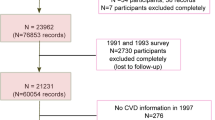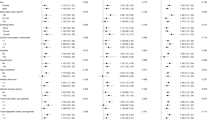Abstract
Background/Objectives:
Prospective cohort studies have shown that high fruit and vegetable consumption is related to a lower risk of stroke. Whether food processing affects this association is unknown. We evaluated the associations of raw and processed fruit and vegetable consumption independently from each other with 10-year stroke incidence and stroke subtypes in a prospective population-based cohort study in the Netherlands.
Subjects/Methods:
We used data of 20 069 men and women aged 20–65 years and free of cardiovascular diseases at baseline who were enrolled from 1993 to 1997. Diet was assessed using a validated 178-item food frequency questionnaire. Hazard ratios (HRs) were calculated for total, ischemic and hemorrhagic stroke incidence using multivariable Cox proportional hazards models.
Results:
During a mean follow-up time of 10.3 years, 233 incident stroke cases were documented. Total and processed fruit and vegetable intake were not related to incident stroke. Total stroke incidence was 30% lower for participants with a high intake of raw fruit and vegetables (Q4: >262 g/day; HR: 0.70; 95% confidence intervals (95% CIs): 0.47–1.03) compared with those with a low intake (Q1: ⩽92 g/day) and the trend was borderline significant (P for trend=0.07). Raw vegetable intake was significantly inversely associated with ischemic stroke (>27 vs ⩽27 g/day; HR: 0.50; 95% CI: 0.34–0.73), and raw fruit borderline significantly with hemorrhagic stroke (>120 vs ⩽120 g/day; HR: 0.53; 95% CI: 0.28–1.01).
Conclusions:
High intake of raw fruit and vegetables may protect against stroke. No association was found between processed fruit and vegetable consumption and incident stroke.
This is a preview of subscription content, access via your institution
Access options
Subscribe to this journal
Receive 12 print issues and online access
$259.00 per year
only $21.58 per issue
Buy this article
- Purchase on Springer Link
- Instant access to full article PDF
Prices may be subject to local taxes which are calculated during checkout
Similar content being viewed by others
References
Bazzano LA, He J, Ogden LG, Loria CM, Vupputuri S, Myers L et al. (2002). Fruit and vegetable intake and risk of cardiovascular disease in US adults: the first National Health and Nutrition Examination Survey Epidemiologic Follow-up Study. Am J Clin Nutr 76, 93–99.
Dauchet L, Amouyel P, Dallongeville J (2005). Fruit and vegetable consumption and risk of stroke: a meta-analysis of cohort studies. Neurology 65, 1193–1197.
De Bruin A, De Bruin EL, Gast A, Kardaun JWPF, van Sijl M, Verweij GCG et al. (2003). Linking Data of National Ambulant Register and GBA Data: Methods, Results and Quality Research (in Dutch). Statistics Netherlands: Voorburg, The Netherlands.
Dutch Food Composition Database (1996): Netherlands Nutrition Centre (in Dutch): The Hague, The Netherlands.
Dutch Food Composition Database (2001): Netherlands Nutrition Centre (in Dutch): The Hague, The Netherlands.
Dutch Institute for Healthcare Improvement (CBO) (2008). Guideline ‘Diagnosis, Treatment and Care for Patients with Stroke’. The Dutch Institute for Healthcare Improvement: Utrecht, The Netherlands. http://www.cbo.nl/Downloads/218/rl_beroerte_09.pdf.
Eichholzer M, Lüthy J, Gutzwiller F, Stähelin HB (2001). The role of folate, antioxidant vitamins and other constituents in fruit and vegetables in the prevention of cardiovascular disease: the epidemiological evidence. Int J Vitam Nutr Res 71, 5–17.
Flood-Obbagy JE, Rolls BJ (2009). The effect of fruit in different forms on energy intake and satiety at a meal. Appetite 52, 416–422.
Gärtner C, Stahl W, Sies H (1997). Lycopene is more bioavailable from tomato paste than from fresh tomatoes. Am J Clin Nutr 66, 116–122.
Gillman MW, Cupples LA, Gagnon D, Posner BM, Ellison RC, Castelli WP et al. (1995). Protective effect of fruits and vegetables on development of stroke in men. JAMA 273, 1113–1117.
He FJ, Nowson CA, MacGregor GA (2006). Fruit and vegetable consumption and stroke: meta-analysis of cohort studies. Lancet 367, 320–326.
Hertog MGL, Hollman PC, Katan MB (1992). Content of potentially anticarcinogenic flavonoids of 28 vegetables and 9 fruits commonly consumed in the Netherlands. J Agric Food Chem 40, 2379–2383.
Hertog MGL, Hollman PCH, Van de Putte B (1993). Content of potentially anticarcinogenic flavonoids of tea infusions, wines, and fruit juices. J Agric Food Chem 41, 1242–1246.
Hirvonen T, Virtamo J, Korhonen P, Albanes D, Pietinen P (2000). Intake of flavonoids, carotenoids, vitamins C and E, and risk of stroke in male smokers. Stroke 31, 2301–2306.
Hord NG, Tang Y, Bryan NS (2009). Food sources of nitrates and nitrites: the physiologic context for potential health benefits. Am J Clin Nutr 90, 1–10.
Jacobs Jr DR, Gross MD, Tapsell LC (2009). Food synergy: an operational concept for understanding nutrition. Am J Clin Nutr 89, 1543S–1548S.
Johnsen SP, Overvad K, Stripp C, Tjønneland A, Husted SE, Sørensen HT (2003). Intake of fruit and vegetables and the risk of ischemic stroke in a cohort of Danish men and women. Am J Clin Nutr 78, 57–64.
Joshipura KJ, Ascherio A, Manson JE, Stampfer MJ, Rimm EB, Speizer FE et al. (1999). Fruit and vegetable intake in relation to risk of ischemic stroke. JAMA 282, 1233–1239.
Keli SO, Hertog MG, Feskens EJ, Kromhout D (1996). Dietary flavonoids, antioxidant vitamins, and incidence of stroke: the Zutphen study. Arch Intern Med 156, 637–642.
Mizrahi A, Knekt P, Montonen J, Laaksonen MA, Heliövaara M, Järvinen R (2009). Plant foods and the risk of cerebrovascular diseases: a potential protection of fruit consumption. Br J Nutr 102, 1075–1083.
Ocké MC, Bueno-de-Mesquita HB, Goddijn HE, Jansen A, Pols MA, van Staveren WA et al. (1997a). The Dutch EPIC food frequency questionnaire. I. Description of the questionnaire, and relative validity and reproducibility for food groups. Int J Epidemiol 26 (Suppl 1), S37–S48.
Ocké MC, Bueno-de-Mesquita HB, Pols MA, Smit HA, van Staveren WA, Kromhout D (1997b). The Dutch EPIC food frequency questionnaire. II. Relative validity and reproducibility for nutrients. Int J Epidemiol 26 (Suppl 1), S49–S58.
Oude Griep LM, Geleijnse JM, Kromhout D, Ocké MC, Verschuren WMM (2010). Raw and processed fruit and vegetable consumption and 10-year coronary heart disease incidence in a population-based cohort study in the Netherlands. PLoS One 5, e13609.
Pols MA, Peeters PH, Ocké MC, Slimani N, Bueno-de-Mesquita HB, Collette HJ (1997). Estimation of reproducibility and relative validity of the questions included in the EPIC Physical Activity Questionnaire. Int J Epidemiol 26 (Suppl 1), S181–S189.
Rickman JC, Bruhn CM, Barrett DM (2007). Nutritional comparison of fresh, frozen, and canned fruits and vegetables II. Vitamin A and carotenoids, vitamin E, minerals and fiber. J Sci Food Agric 87, 1185–1196.
Ruxton CH, Gardner EJ, Walker D (2006). Can pure fruit and vegetable juices protect against cancer and cardiovascular disease too? A review of the evidence. Int J Food Sci Nutr 57, 249–272.
Sauvaget C, Nagano J, Allen N, Kodama K (2003). Vegetable and fruit intake and stroke mortality in the Hiroshima/Nagasaki life span study. Stroke 34, 2355–2360.
Scholte op Reimer WJ, Dippel DW, Franke CL, van Oostenbrugge RJ, de Jong G, Hoeks S et al. (2006). Quality of hospital and outpatient care after stroke or transient ischemic attack: insights from a stroke survey in the Netherlands. Stroke 37, 1844–1849.
Steffen LM, Jacobs DR, Stevens J, Shahar E, Carithers T, Folsom AR (2003). Associations of whole-grain, refined-grain, and fruit and vegetable consumption with risks of all-cause mortality and incident coronary artery disease and ischemic stroke: the Atherosclerosis Risk in Communities (ARIC) study. Am J Clin Nutr 78, 383–390.
US Department of Health and Human Services and US Department of Agriculture (2005). Dietary Guidelines for Americans, 6th edn. US Government Printing Office: Washington, DC.
van het Hof KH, West CE, Weststrate JA, Hautvast JG (2000). Dietary factors that affect the bioavailability of carotenoids. J Nutr 130, 503–506.
Verschuren WMM, Blokstra A, Picavet HS, Smit HA (2008). Cohort profile: the Doetinchem Cohort Study. Int J Epidemiol 37, 1236–1241.
World Health Organization (WHO) (1977). International Classification of Diseases, 9th Revision. World Health Organization: Geneva, Switzerland.
World Health Organization (WHO) (1990). International Classification of Diseases, 10th Revision. World Health Organization: Geneva, Switzerland.
Acknowledgements
Dr Geleijnse obtained an unrestricted grant (13281) from the Product Board for Horticulture, Zoetermeer, the Netherlands to cover the costs of data analysis for the present study. The other authors did not report financial disclosures. The Monitoring Project on Risk Factors and Chronic Diseases in the Netherlands (MORGEN) Study was supported by the Ministry of Health, Welfare and Sport of the Netherlands, the National Institute of Public Health and the Environment, Bilthoven, the Netherlands and the Europe against Cancer Program of the European Union. The sponsors did not participate in the design or conduct of the study; in the collection, analysis or interpretation of the data; or in the preparation, review or approval of the manuscript.
Author information
Authors and Affiliations
Corresponding author
Ethics declarations
Competing interests
The authors declare no conflict of interest.
Additional information
Contributors: LMOG, DK and JMG contributed to study concept and design, and data analysis and interpretation; WMMV and MCO contributed to data acquisition; LMOG contributed to drafting of the manuscript; WMMV, DK, MCO and JMG contributed to critical revision of the manuscript for important intellectual content; LMOG contributed to statistical analysis; WMMV and JMG obtained funding; WMMV and JMG provided administrative, technical or material support; WMMV, DK and JMG done study supervision.
Rights and permissions
About this article
Cite this article
Oude Griep, L., Verschuren, W., Kromhout, D. et al. Raw and processed fruit and vegetable consumption and 10-year stroke incidence in a population-based cohort study in the Netherlands. Eur J Clin Nutr 65, 791–799 (2011). https://doi.org/10.1038/ejcn.2011.36
Received:
Revised:
Accepted:
Published:
Issue Date:
DOI: https://doi.org/10.1038/ejcn.2011.36
Keywords
This article is cited by
-
Curcumin prevents strokes in stroke-prone spontaneously hypertensive rats by improving vascular endothelial function
BMC Cardiovascular Disorders (2018)
-
Dietary and circulating lycopene and stroke risk: a meta-analysis of prospective studies
Scientific Reports (2014)
-
Relation of raw and cooked vegetable consumption to blood pressure: the INTERMAP Study
Journal of Human Hypertension (2014)
-
Adherence to the USDA dietary recommendations for fruit and vegetable intake and risk of fatal stroke among ethnic groups: a prospective cohort study
BMC Neurology (2013)
-
Diet and risk of chronic diseases: results from the first 8 years of follow-up in the EPIC-Potsdam study
European Journal of Clinical Nutrition (2013)



